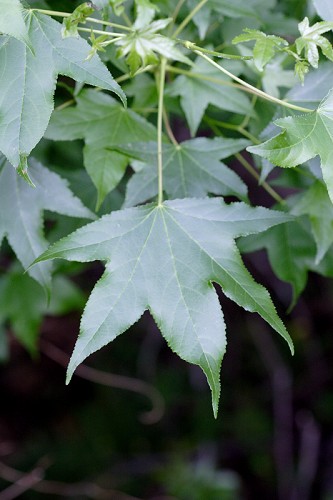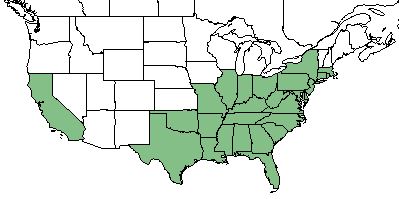Liquidambar styraciflua
Common name: sweetgum,[1] red gum[2]
| Liquidambar styraciflua | |
|---|---|

| |
| Photo by the Southeastern Flora Database | |
| Scientific classification | |
| Kingdom: | Plantae |
| Division: | Magnoliophyta - Flowering plants |
| Class: | Magnoliopsida - Dicots |
| Order: | Hamamelidales |
| Family: | Hamamelidaceae |
| Genus: | Liquidambar |
| Species: | L. styraciflua |
| Binomial name | |
| Liquidambar styraciflua L. | |

| |
| Natural range of Liquidambar styraciflua from USDA NRCS Plants Database. | |
Contents
Taxonomic Notes
Synonyms: none[2]
Varieties: none[2]
Description
L. styraciflua is a perennial tree of the Hamamelidaceae family native to North America.[1]
Distribution
L. styraciflua ranges from Connecticut, west to southern Ohio, Illinois, and Oklahoma, and south to southern Florida, Texas, and Guatemala.[2]
Ecology
Habitat
L. styraciflua is found in swamp forests, floodplains, moist forests, depressional wetlands, old fields, and disturbed areas.[2] Specimens have been collected from hardwood swamp, lowland woodland, wet hammock, lake edges, pine woods, mixed woodland, wet slash pine, sand bluffs, and the edge of mesic woodlands.[3]
L. styraciflua was found to increase its presence in response to soil disturbance by heavy silviculture in North Carolina. It has shown regrowth in reestablished native longleaf pine sites that were disturbed by these practices.[4] It became absent in response to soil disturbance by military training in west Georgia longleaf pinelands.[5] It was found to decrease its cover in response to soil disturbance by clearcutting and chopping in north Florida flatwoods.[6] Additionally, L. styraciflua decreased its frequency in response to soil disturbance by roller chopping in east Texas pinelands.[7] It has shown resistance to regrowth in reestablished pinelands and flatwoods that were disturbed by these practices.[5][6][7] This species had no response to soil disturbance by improvement logging in Mississippi.[8] It also had variable changes in frequency in response to soil disturbance by KG blade in east Texas pinelands. In some reestablished post-disturbance habitat, the plant exhibited regrowth, and in others the plant resisted regrowth.[7]
Liquidambar styraciflua is frequent and abundant in the North Florida Longleaf Woodlands community type as described in Carr et al. (2010).[9]
Phenology
L. styraciflua flowers from April through May.[10]
Fire ecology
L. styraciflua is quite fire resistant,[11] as populations have been known to persist through repeated annual burns.[12][13]
Herbivory and toxicology
L. styraciflua has been observed to host cicadas such as Magicicada tredecim (family Cicadidae), ladybugs such as Harmonia axyridis (family Coccinellidae), and treehoppers such as Cyrtolobus tuberosus (family Membracidae).[14] L. styraciflua has medium palatability for browsing animals[1], and the bark is a favorite food of beavers.
Conservation, cultivation, and restoration
L. styraciflua is listed as a species of special concern by the Connecticut Department of Environmental Protection.[1]
Cultural use
Twigs soaked in water or whiskey functioned as early toothbrushes in Appalachia. The resin was used to dress wounds and treat fever, while the gum was used in treating herpes, inflammation, and toothache.[15] The sap used to be gathered as chewing gum.[2] Leaves were boiled to apply to cuts or sore feet.[16]
A drug for treating scabies is made from this tree.[17]
Photo Gallery
References and notes
- ↑ 1.0 1.1 1.2 1.3 USDA Plant Database https://plants.usda.gov/core/profile?symbol=LIST2
- ↑ 2.0 2.1 2.2 2.3 2.4 2.5 Weakley, A.S. 2020. Flora of the Southeastern United States. Edition of 20 October 2020. University of North Carolina at Chapel Hill, Chapel Hill, North Carolina.
- ↑ URL: http://herbarium.bio.fsu.edu. Last accessed: June 2018. Collectors: Cecil Slaughter, R.K. Godfrey, Kathy Craddock Burks, David A. Breil, Kurt Blum, Andre F. Clewell, Patricia Elliot, Gary Knight, A. Gholson Jr., Richard P. Wunderlin, Bruce Hansen, Karen MacClendon, Paul L. Redfearn, M.P. Burbank, Sherman, Shamblee, John W. Thieret, G.S. Ramseur, A.E. Hammond, Windler, M. Burch, Clarke Hudson, D.S. Correll, Raymond Jones, R. E. Wicker, Ed Keppner, Lisa Keppner, Richard Gaskalla, Ana Ochoa, Marc Minno. States and counties: Florida (Marion, Leon, Jefferson, Liberty, Walton, Dixie, Jackson, Santa Rosa, Levy, Hernando, Madison, Gadsden, Hillsborough, Wakulla, Calhoun, Osceola, Baker, St. Johns, Washington, Holmes) Georgia (THomasGrady, De kalb, Clarke) Arkansas (Stone, Searcy, Marion) North Carolina (Moore, Alamance) West Virginia (Cabell) Louisiana (Washington, Bienville, Evangeline, Tangipahoa, Lafayette, Lincoln) Tennessee (Coffee) Maryland (St. Marys) Mississippi (Forrest)
- ↑ Cohen, S., R. Braham, and F. Sanchez. (2004). Seed Bank Viability in Disturbed Longleaf Pine Sites. Restoration Ecology 12(4):503-515.
- ↑ 5.0 5.1 Dale, V.H., S.C. Beyeler, and B. Jackson. (2002). Understory vegetation indicators of anthropogenic disturbance in longleaf pine forests at Fort Benning, Georgia, USA. Ecological Indicators 1(3):155-170.
- ↑ 6.0 6.1 Moore, W.H., B.F. Swindel, and W.S. Terry. (1982). Vegetative Response to Clearcutting and Chopping in a North Florida Flatwoods Forest. Journal of Range Management 35(2):214-218.
- ↑ 7.0 7.1 7.2 Stransky, J.J., J.C. Huntley, and Wanda J. Risner. (1986). Net Community Production Dynamics in the Herb-Shrub Stratum of a Loblolly Pine-Hardwood Forest: Effects of CLearcutting and Site Preparation. Gen. Tech. Rep. SO-61. New Orleans, LA: U.S. Dept of Agriculture, Forest Service, Southern Forest Experiment Station. 11 p.
- ↑ McComb, W.C. and R.E. Noble. (1982). Response of Understory Vegetation to Improvement Cutting and Physiographic Site in Two Mid-South Forest Stands. Southern Appalachian Botanical Society 47(1):60-77.
- ↑ Carr, S.C., K.M. Robertson, and R.K. Peet. 2010. A vegetation classification of fire-dependent pinelands of Florida. Castanea 75:153-189.
- ↑ Nelson, G. PanFlora: Plant data for the eastern United States with emphasis on the Southeastern Coastal Plains, Florida, and the Florida Panhandle. www.gilnelson.com/PanFlora/ Accessed: 24 MAY 2018
- ↑ Brockway, D. G., et al. (2005). Restoration of longleaf pine ecosystems. F. S. United States Department of Agriculture, Southern Research Station.
- ↑ Robertson, K.M. Unpublished data collected from Pebble Hill Fire Plots, Pebble Hill Plantation, Thomasville, Georgia.
- ↑ Glitzenstein, J. S., D. R. Streng, R. E. Masters, K. M. Robertson and S. M. Hermann 2012. Fire-frequency effects on vegetation in north Florida pinelands: Another look at the long-term Stoddard Fire Research Plots at Tall Timbers Research Station. Forest Ecology and Management 264: 197-209.
- ↑ Discoverlife.org [1]
- ↑ Korchmal, Arnold & Connie. 1973. A Guide to the Medicinal Plants of the United States. The New York Times Book Company, New York.
- ↑ Korchmal, Arnold & Connie. 1973. A Guide to the Medicinal Plants of the United States. The New York Times Book Company, New York.
- ↑ Korchmal, Arnold & Connie. 1973. A Guide to the Medicinal Plants of the United States. The New York Times Book Company, New York.